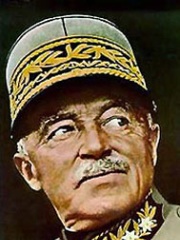
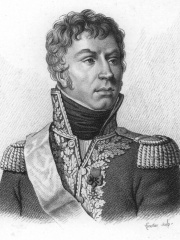
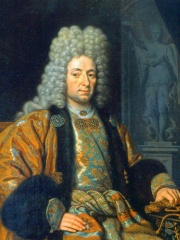
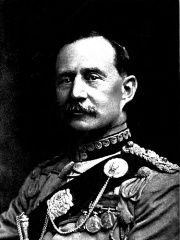
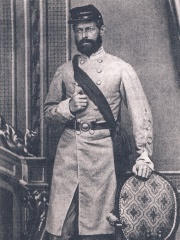
The Most Famous
MILITARY PERSONNELS from Switzerland
This page contains a list of the greatest Swiss Military Personnels. The pantheon dataset contains 2,058 Military Personnels, 6 of which were born in Switzerland. This makes Switzerland the birth place of the 42nd most number of Military Personnels behind Slovakia, and Latvia.
Top 6
The following people are considered by Pantheon to be the most legendary Swiss Military Personnels of all time. This list of famous Swiss Military Personnels is sorted by HPI (Historical Popularity Index), a metric that aggregates information on a biography's online popularity.

1. Henri Guisan (1874 - 1960)
With an HPI of 67.91, Henri Guisan is the most famous Swiss Military Personnel. His biography has been translated into 31 different languages on wikipedia.
Henri Guisan (French pronunciation: [ɑ̃ʁi ɡizɑ̃]; 21 October 1874 – 7 April 1960) was a Swiss military officer who held the office of General of the Swiss Armed Forces during the Second World War. He was the fourth and the most recent person to be appointed to the rarely used Swiss rank of general, and was possibly Switzerland's most famous soldier. He is best remembered for effectively mobilizing the Swiss military and population in order to prepare resistance against a possible invasion by Nazi Germany in 1940. Guisan was voted the fourth-greatest Swiss figure of all time in 2010.

2. Jean Reynier (1771 - 1814)
With an HPI of 58.62, Jean Reynier is the 2nd most famous Swiss Military Personnel. His biography has been translated into 17 different languages.
Jean Louis Ébénézer Reynier (French pronunciation: [ʒɑ̃ lwi ebeneze ʁɛnje]; 14 January 1771 – 27 February 1814) was a Swiss-French military officer who served in the French Army during the French Revolutionary Wars and the Napoleonic Wars. He rose in rank to become a general during the War of the First Coalition, and led a division under Napoleon Bonaparte in the French campaign in Egypt and Syria. Under the First Empire, Reynier continued to hold important combat commands, eventually leading an army corps during the Peninsular War in 1810–1811, playing a minor role in the invasion of Russia and then seeing action in Germany all during the War of the Sixth Coalition.

3. François Le Fort (1656 - 1699)
With an HPI of 58.12, François Le Fort is the 3rd most famous Swiss Military Personnel. His biography has been translated into 21 different languages.
François Jacques Le Fort also spelled Lefort (Russian: Франц Яковлевич Лефорт, romanized: Frants Yakovlevich Lefort; 12 January [O.S. 2 January] 1656 – 12 March [O.S. 2 March] 1699) was a Genevan-born Russian military leader of Huguenot origin. He served as general admiral (1695) and was a close associate of Tsar Peter the Great.

4. Lionel Dunsterville (1865 - 1946)
With an HPI of 56.16, Lionel Dunsterville is the 4th most famous Swiss Military Personnel. His biography has been translated into 16 different languages.
Major-General Lionel Charles Dunsterville (9 November 1865 – 18 March 1946) was a British Indian Army officer, who led Dunsterforce across present-day Iraq and Iran towards the Caucasus and Baku during the First World War.
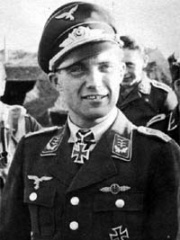
5. Franz von Werra (1914 - 1941)
With an HPI of 53.20, Franz von Werra is the 5th most famous Swiss Military Personnel. His biography has been translated into 15 different languages.
Franz Xaver Freiherr von Werra (13 July 1914 – 25 October 1941) was a German World War II fighter pilot and flying ace who was shot down over Britain and captured. He was the only Axis prisoner of war to escape from Canadian custody and return to Germany apart from a U-boat seaman, Walter Kurt Reich, said to have jumped from a Polish troopship into the St. Lawrence River in July 1940. Werra managed to return to Germany via the US, Mexico, South America and Spain, finally reaching Germany on 18 April 1941. Oberleutnant von Werra was awarded the Knight's Cross of the Iron Cross on 14 December 1940. His story was told in the book The One That Got Away by Kendall Burt and James Leasor, which was made into a film of the same name, starring Hardy Krüger.

6. Henry Wirz (1823 - 1865)
With an HPI of 51.71, Henry Wirz is the 6th most famous Swiss Military Personnel. His biography has been translated into 16 different languages.
Captain Henry Wirz (born Hartmann Heinrich Wirz; November 25, 1823 – November 10, 1865) was a Confederate States Army officer and doctor who served in the American Civil War. Born in Zurich, Switzerland, Wirz immigrated to the United States in 1849 after being exiled from the canton of Zurich following a conviction of embezzlement and fraud. He worked in a Massachusetts factory for five years before moving south to Kentucky to begin a career in medicine; specializing in homeopathic medicine, Wirz divided his time between the two states. In 1854, he moved to Louisiana with his newly-married wife and her two daughters, working as an overseer on a slave plantation. When the Civil War broke out in 1861, Wirz enlisted in the Confederate army. In 1862, he was promoted to captain and placed in charge of managing Confederate prisoner-of-war camps, and two years later was made commandant of the newly-built Camp Sumter, where approximately 45,000 Union prisoners of war were kept during the camp's 14-month existence. Following the Confederate defeat in 1865, Wirz was arrested and tried by the U.S. government on charges of mistreating and murdering Union POWs in the camp. Found guilty of conspiracy and murder, he was executed by hanging in the Old Capitol Prison. Wirz's legacy has been contested since his death, with many Southerners viewing his post-war trial as being a form of victor's justice.
People
Pantheon has 6 people classified as Swiss military personnels born between 1656 and 1914. Of these 6, none of them are still alive today. The most famous deceased Swiss military personnels include Henri Guisan, Jean Reynier, and François Le Fort.
Deceased Swiss Military Personnels
Go to all RankingsHenri Guisan
1874 - 1960
HPI: 67.91
Jean Reynier
1771 - 1814
HPI: 58.62
François Le Fort
1656 - 1699
HPI: 58.12
Lionel Dunsterville
1865 - 1946
HPI: 56.16
Franz von Werra
1914 - 1941
HPI: 53.20
Henry Wirz
1823 - 1865
HPI: 51.71
Overlapping Lives
Which Military Personnels were alive at the same time? This visualization shows the lifespans of the 4 most globally memorable Military Personnels since 1700.

